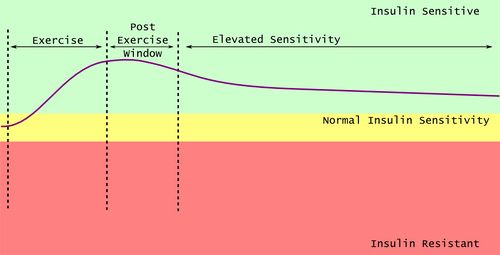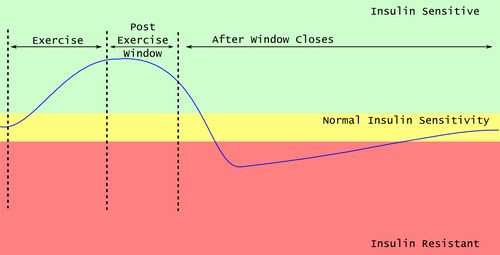Nutrient Timing
Recent research has revealed that when you eat can be more important for an athlete than what you eat. Timing your recovery nutrition correctly can…
- Reduce muscle damage
- Improve muscle recovery and rebuilding
- Increase Glycogen stores
- Reduce body fat
- Mitigate immune system suppression
The book Nutrient Timing by John Ivy has provided a great summary of the research and is highly recommended.
Contents
1 Timing
After exercise, muscles have increased sensitivity to insulin. Insulin is a hormone that is released in response to a rise in blood sugar. It is often considered A Bad Thing, as it will normally cause the blood sugar to be stored as fat. However, after exercise, insulin will cause the blood sugar to be stored as Glycogen in the muscles and cause Protein to be used for muscle synthesis. If you take carbohydrate and Protein within 45 minutes of exercise, the insulin sensitivity can be continued for up to 6 hours.
Without nutrient intake, the muscles' insulin sensitivity will decline after exercise, and actually become insulin resistant. The nutrition from any food or drink taken while the muscles are insulin resistant will be stored as fat, leaving the muscles deprived.
2 What fuel?
Muscles are continually being broken down and rebuilt, and the balance between this breakdown and synthesis is the net change in muscle. In a fasted state, the rate of breakdown exceeds the rate of synthesis, and we're losing muscles. (This is why GOMAD Grazing takes a continuous feeding approach.) After exercise, but before refueling, the rate of breakdown is higher, but the synthesis has gone up even slightly more than the rate of breakdown, so there's still a net muscle loss, just not as fast. Taking carbohydrate after exercise will reduce the rate of breakdown, but does not increase synthesis, so it's still a net muscle loss. It's only when the fueling includes Protein that the rate of synthesis exceeds the rate of breakdown.
If you look at Glycogen synthesis, taking Protein and carbohydrate replenishes Glycogen faster than without the Protein. However, taking the same number of calories of carbohydrate as in the Protein and carbohydrate scenario actually produces greater Glycogen replenishment. So for maximal Glycogen storage, pure carbohydrates are best. However, this is not normally our objective unless we are Carbohydrate Loading before an event.
If we look at the insulin response to the same scenarios, we see that carbohydrate and Protein has the greatest impact. This insulin will act as a growth hormone and helps boost muscle synthesis.
3 The Nutrient Timing System Summary
The Nutrient Timing System (NTS) is designed for strength rather than endurance athletes.
3.1 NTS During Exercise
Taking Protein with carbohydrate can reduce the damage to muscles and support the immune system. The ratio of 1:4 Protein to carbohydrate has been shown to be effective, though other ratios from 1:2 to 1:6 also work.
3.2 NTS Immediately after exercise
Taking a carbohydrate/Protein mix immediately following exercise improves recovery and muscle synthesis. Again 1:4 has shown to be effective, but other ratios also work. John Ivy's book recommends 15 grams of whey Protein with 50 grams of carbohydrate, providing 220-260 calories. This should be easily digested so that it can be used by the body quickly. This should be taken within 40 minutes of completing the exercise and ideally as soon as practical after finishing the exercise.
3.3 NTS Post Exercise
From 1-4 hours after exercise, continued fueling can maintain the muscle's sensitivity to insulin. Using a ratio with more Protein and less carbohydrate is generally recommended. John Ivy's book recommends 14 grams Protein to 2-4 grams carbohydrate taken within 4 hours of exercise.
4 NTS Sustaining Recovery
From 4 hours after exercise to the beginning of the next session, the recommendation is to take sufficient Protein to keep the body provided with the nutrients for muscle synthesis. There is some suggestion that slow digesting Protein, such as Casein, is more effective than whey.
5 Fellrnr's Endurance Nutrient Timing System
I have been experimenting with NTS as an endurance athlete since Dec 2010. This section documents my approach and findings, but remember I am typically following this approach after extended exercise (3+ hours).
5.1 ENTS Pre-Exercise
I have a breakfast of 25g Whey Protein, Choline, 1/4 teaspoon salt, 1 tablespoon Cocoa powder and Metamucil. This is normally taking 1-2 hours before starting my run.
5.2 ENTS During Exercise
I use a ratio of between 1:3 and 1:4 Protein to carbohydrate using Optimum Nutrition 100% Whey (Vanilla) mixed with Carbohydrate. I started off using Gatorade, but I moved to Gatorade/Maltodextrin then Sugar/Maltodextrin. I find the mixture tastes pretty good and gives no digestive distress. I also add 1/4 tsp salt per quart to provide more electrolytes. More details at Fellrnr's Go Juice
5.3 ENTS Immediately after exercise
I find that I benefit from taking more Protein than NTS recommends. I take 25g Whey Protein, 5g Glutamine, 5g BCAA and 65g Gatorade immediately after exercise (400 Calories). I will then take 25g Whey Protein + 30g Gatorade at about 30 minutes, 60 minutes and 120 minutes after completion. The exact number and doses depends on how I feel and the timing is based around appetite rather than the clock.
5.4 ENTS Post Exercise
At about 2 hours after exercise I change the mixture to 25g Whey Protein + 25g Casein Protein + 30g Gatorade + 1 tablespoon flax oil. I also add Metamucil Fiber to slow digestion and keep the digestive system happy. Sometimes I will not bother with the Whey and just use the Casein.
At about 3 hours after exercise I change things again. At this point I move away from the fast carbs to skim milk, which provides slow carbs. Typically I'll take 25g Whey Protein + 25g Casein Protein + 16oz Skim Milk + 1 tablespoon flax oil. Again I will add Metamucil.
5.5 Sustaining Recovery
After 4 hours I will continue to have the occasional Protein drink, including one with a banana and spinach. I will typically eat a large salad (1-2 heads of lettuce, 1/2 cucumber, several tomatoes, olives, nuts, 1-2 cans beets, 1/2 can sweetcorn, etc.)
5.6 GOMAD Grazing
I've also used an approach I call GOMAD Grazing for the ENTS Post Exercise period, which works quite well.
5.7 Example Routine
| Time | Protein | Fast Carbs | Slow Carbs | Fat | Calories | Ingredients |
| Breakfast | 25 | 0 | 0 | 0 | 100 | 1 scoop Whey, Cocoa powder, Choline, Salt |
| Finish | 35 | 64 | 0 | 0 | 396 | 1 scoop Gatorade, 1 scoop Whey, 5g Glutamine, 5g BCAA |
| Finish+30 mins | 25 | 32 | 0 | 0 | 228 | 1/2 scoop Gatorade, 1 scoop Whey |
| Finish+60 mins | 25 | 32 | 0 | 0 | 228 | 1/2 scoop Gatorade, 1 scoop Whey |
| Finish+120 mins | 25 | 32 | 0 | 0 | 228 | 1/2 scoop Gatorade, 1 scoop Whey |
| Finish+180 mins | 50 | 32 | 0 | 15 | 463 | 1/2 scoop Gatorade, 1 scoop Whey, 1 scope casein, 1 tbl flax |
| Finish+240 mins | 78 | 0 | 38 | 15 | 599 | 16oz skim milk, 1 scoop Whey, 1 scope casein, 1 tbl flax, Metamucil |
| Totals | 263 | 192 | 38 | 30 | 2242 |
6 Fellrnr's Experience
- I feel the effects of a training run much less. I'm mentally more focused and physically less sore. Sometimes it almost feels like I've not been for a run.
- In the past, I suffer from a muzzy, thick headed feeling after particularly hard training run such as a sub-3 hour marathon distance. Using the nutrient timing approach I am much more 'normal', though I still feel the effects.
- My body weight has increased slightly and my body fat has decreased. I am seeing this decrease using skin fold calipers, the mirror and the 'jeans fit' methods ;}
- I suspect my calorie intake for the rest of the day has decreased somewhat as my appetite has lowered. Following 'the end of overeating' has helped curb my excessive intake.
- My Protein intake has gone from about 160-200 grams (2.5g/Kg-3.2g/Kg) to about 300+ grams (4.8g/Kg) on training days. This is higher than the highest recommendations for Protein intake. However, as a percentage of calories, this is probably somewhat reasonable (300 grams is 1200 calories, with a 4000 calorie diet is 30%).




